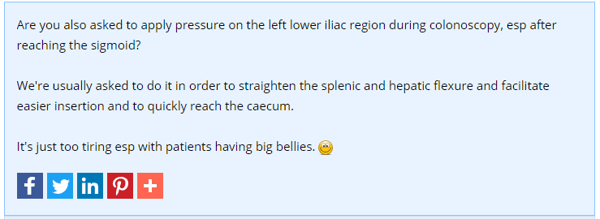Nurse Injuries Hurt Patients & Hospitals
by Larissa Biggers, on September 07, 2018
Nurses who handle patients on a regular basis are likely to get injured, sooner or later. According to the U.S. Bureau of Labor Statistics, nursing has the highest rate of nonfatal occupational injuries of any profession, (yes, even higher than construction workers or factory employees), and an American Nursing Association survey revealed that 62 percent of nurses indicated that the risk of developing a disabling musculoskeletal disorder was a top health and safety concern.
Most of these injuries stem from patient handling tasks such as lifting, repositioning, and transporting patients, often from extremely awkward positions.

 Examples of endoscopy nurse patient handling duties during colonoscopy (from allnurses chat group)
Examples of endoscopy nurse patient handling duties during colonoscopy (from allnurses chat group)
Patients Pay the Price
Injuries to nursing staff impact patients. According to one study, 22 percent of nurses reported being less friendly or engaging with their patients due to physical discomfort, and 22 percent also modified or limited their activity/movement on the job. The Occupational Safety and Health Administration (OSHA) notes that risks to staff and patients are intermingled.“Caregivers and patients face many related hazards." For instance, manual lifting can injure nurses, limiting their physical capabilities. This subsequently puts patients at risk for falls, fractures, bruises, and skin tears. Furthermore, staff fatigue, injury, and stress are tied to a higher possibility of medication errors and patient infections.
Fewer Nurses, More Burdens
Injury also contributes to the nursing shortage. OSHA reports that as many as 20% of nurses who leave direct patient care positions do so because of risks associated with their work.
According to the latest National Healthcare Retention & RN Staffing Report, annual turnover rate for nurses is 17.1% nationwide; the vacancy rate for RNs is 8.5% and continues to rise. Fewer nurses mean larger patient loads and less time to dedicate to patient care. Not surprisingly, this can affect patient outcomes and experience. For every patient added to a nurse’s workload, there is a 23% increase in burnout and a 15% increase in job dissatisfaction. Hiring temporary nurses is not a permanent solution. This practice can also contribute to an unsafe working environment, in part because these employees are less familiar with work and safety procedures and policies.
One Unhappy Patient Costs Hospitals a Lot
The lifetime value of a patient is estimated to be approximately $1.4 million. When patients have a bad experience at one hospital and go somewhere else for care, that money goes with them, along with prospective patients who read their negative online reviews. (An NRC Health survey indicates that more than 32% of those who visit a hospital website say reviews are the most important thing on the site.)
![]()
Patient experience measurements have become vital to a healthcare facility’s livelihood in other ways. In 2013 the Centers for Medicare & Medicaid instituted value-based purchasing under which hospitals are financially rewarded or penalized based on performance on various measures, including patient experience. Studies show that a positive patient experience is associated with increased profitability, and a negative one is even more strongly linked to decreased profitability.
A Wise Investment
While there are some programs in place to protect healthcare workers from injury, in the U.S., most current efforts and legislation are focused on patients. Considering the impact that nurse injuries have on the patient experience, healthcare facilities should allocate adequate funds to remedy this situation. An investment in safety equipment, education, and programs for employees translate to a much better bottom line for hospitals.


